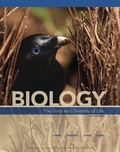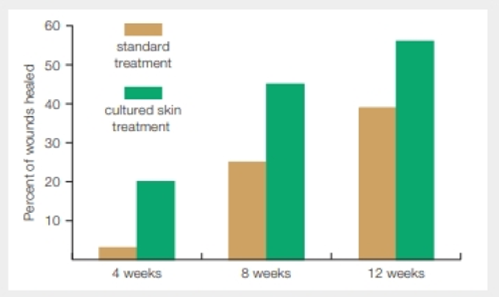
Concept explainers
Cultured Skin for Healing Wounds Diabetes is a disorder in which the blood sugar level is not properly controlled. Among other effects, it reduces blood flow to the lower legs and feet. As a result, about 3 million diabetes patients have ulcers (open wounds that do not heal) on their feet. Each year, about 80,000 require amputations.
Several companies provide cultured cell products designed to promote the healing of diabetic foot ulcers. FIGURE 31.15 shows the results of a clinical experiment that tested the effect of one such cultured skin product versus standard treatment for diabetic foot wounds. Patients were randomly assigned to either the experimental treatment group or the control group, and their progress was monitored for 12 weeks.

FIGURE 31.15 Treatment of diabetic food ulcers. Results of a multicenter study of the effects of standard treatment versus use of a cultured cell product for diabetic foot ulcers. Bars show the percentage of foot ulcers that had completely healed.
How early was the healing difference between the control and treatment groups obvious?
Want to see the full answer?
Check out a sample textbook solution
Chapter 31 Solutions
Biology: The Unity and Diversity of Life (MindTap Course List)
- Ca2+-ATPases are integral membrane proteins. They are active transport mechanisms that use the energy derived from ATP hydrolysis to pump calcium ions across the membrane. A specific form of Ca2+-ATPase, ERCA, is located on the endoplasmic reticulum membrane. In which direction does ERCA transport calcium ions? a.) ERCA transports calcium ions from the lumen of the endoplasmic reticulum into the cytoplasm. b.) ERCA transports calcium ions from the cytoplasm into the lumen of the endoplasmic reticulum.arrow_forwardYou are a physician treating a patient with cancer. Based on our lecture, which of the following drugs might be useful to look into to treat the patient? a drug that shifts the metabolism of the cancer cells toward oxidative phosphorylation, a drug that shifts the metabolism of the cancer cells toward glycolysis. a drug that activates cell division in the cancer cells. a drug that activates signaling downstream of growth factorsarrow_forwardExposing cells to which of the following drugs would inhibit the slow output response of a cell to a signaling ligandwithout having an effect on the fast output response ? A. Latrunculin - a molecule isolated from sponges, which binds near the nucleotide-binding cleft of monomericactin.B. Taxol - a molecule isolated from the bark of the pacific yew, which that stabilizes microtubules.C. Alpha-amanitin - a molecule isolated from deathcap mushrooms, which blocks RNA polymerase II.D. Phalloidin - a molecule isolated from deathcap mushrooms that stabilizes f-actin.E. Sodium orthovanadate - a molecule that inhibits alkaline and tyrosine phosphatases.arrow_forward
- A. Fill in the blank: The motor protein responsible for transporting vesicles to the plasma membrane is named ____________. (spelling matters!) B. Specific inhibitors of dyneins have yet to be discovered. When they are discovered, how would they most likely affect cells? Reduce retrograde transport of endosomes Decrease pseudopod formation in amoeboid cells Increase cell size Decrease contraction of skeletal musclearrow_forwardSome cells in the pancreatic acinus form vesicles containing zymogens. Then the cells secrete the zymogens. Certain proteins called v-SNARES play a role in this process. What best describes the proteins called v-SNARES? a.) v-SNARES are proteins on the cytosolic face of the plasma membrane that help vesicles to fuse with the plasma membrane b.) v-SNARES are a type of glycosphingolipid in the vesicle lipid bilayer that help maintain vesicle integrity c.) v-SNARES are proteins on the surface of vesicles that help the vesicle fuse with the cytosolic face of the plasma membrane d.) v-SNARES are proteins contained inside of vesicles that help stabilize the vesicle contents until the vesicle fuses with the cytosolic face of the plasma membranearrow_forwardTight junctions are protein junctions that provide a water-tight seal between cells. They ensure that materials must enter the cells (through diffusion or active transport) to pass through the tissue. Tight junctions are characteristic of cells lining the digestive tract, where materials are required to pass through cells (not between them) before they can travel into the blood. Can someone explain more clearly why lining the digestive tract?arrow_forward
- Calculate the number of cells in the body of an average 68-kg (150-lb) adult. (This will only be accurate to about 1 part in 10 but should give you an idea how scientists estimate this commonly quoted number.) Assume all cells are spheres 20 m in diameter. The volume of a sphere can be determined by the equation v=4/33. (Hint: We know that about two thirds of the water in the body is intracellular and the density of cells is nearly 1 g/mL. The proportion of the mass made up of water is about 60%.)arrow_forwardSNAT2 (a membrane protein) determines the cell’s content of most amino acids. It acts as a symport (or co-transporter) of Na+ and amino acids. On the outside of the cell, the Na+ concentration is higher than the inside. The amino acid concentration on the inside of the cell is higher than the outside. When both Na+ and an amino acid bind to the SNAT2 membrane channel on the outside of the cell, there is a conformational change allowing the energy from electrochemical gradient of Na+ for the transport of the amino acid into the cell. a. Draw this scenario and label your representations of Na+, amino acids, SNAT2, and the membrane. b. What kind of transport is this, simple diffusion, facilitated, diffusion, active transport, 1o active transport, or 2o active transport? Explain your choice. Thanksarrow_forwardSUBJECT : HUMAN NUTRTION AND DIET Please elaborate the risk of type 11 diabetes with ketogenic diet. Share your experience how to avoid keto flu? Give you insights once a cancer cell emerges, how does it become clinically evident?arrow_forward
- Why do cancer cells treated with vitamin E succinate appear to be more vulnerable to rupture of their lysosomal membranes (and subsequent apoptosis) than normal cells? A. cancer cells often have an alkaline cytosol, which destabilizes the acidic lysosomes B. cancer cells often have an alkaline cytosol, which destabilizes the alkaline lysosomes C. cancer cells often have an acidic cytosol, which destabilizes the acidic lysosomes D. cancer cells often have an acidic cytosol, which destabilizes the alkaline lysosomes E. all of the abovearrow_forwardLiver cells proliferate excessively both in patients with chronic alcoholism and in patients with liver cancer. Is alcohol an anti-apoptopic compound? 2. Through diagrams with labeling and description, describe how signals such as taste and light are transmitted.arrow_forwardPlants are often subjected to warm temperatures. How might they adjust their cell membranes to deal with these temperature changes? (Choose All That Apply) change the type of DNA that is found in the membrane increase the amount of unsaturated fatty acids in the phospholipids increase the amount of saturated fats in the membrane increase the amount of sterols found in the membrane Please highlight the correct answerarrow_forward
 Human Physiology: From Cells to Systems (MindTap ...BiologyISBN:9781285866932Author:Lauralee SherwoodPublisher:Cengage Learning
Human Physiology: From Cells to Systems (MindTap ...BiologyISBN:9781285866932Author:Lauralee SherwoodPublisher:Cengage Learning
